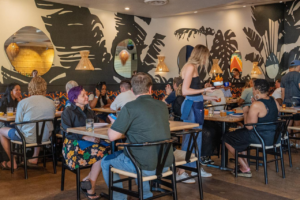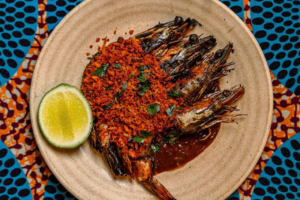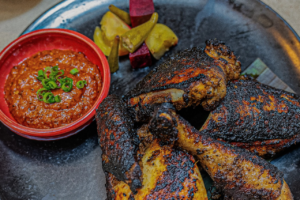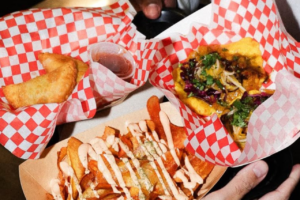In the bustling kitchen of Canje, where modern Caribbean cuisine meets Texas heat, the rhythmic thwacking of coconuts against steel marks a daily ritual that sets this restaurant apart. Harvard Aninye’s approach to coconut milk production isn’t merely about ingredients—it’s a testament to the transformative power of patience and precision in contemporary cuisine.
Every other day, the kitchen undertakes what might seem like a Herculean task to most restaurants: processing twenty fresh coconuts to yield twenty quarts of coconut milk. The process begins with what Aninye calls “the coconut test”—a deceptively simple assessment where the weight and density of each fruit tells its own story. “You can tell when a coconut is ready to go and nice and fresh by how dense and heavy it is,” he explains, demonstrating the kind of intuitive knowledge that comes only through years of hands-on experience.
The methodology itself is a dance of tradition and efficiency. Armed with a knife that “scares people a lot of times,” Aninye demonstrates his technique of striking each coconut at precise angles—a skill that transforms what could be a dangerous task into an art form. The real magic, however, lies in the extraction process. Unlike the convenient but often one-dimensional store-bought varieties, Canje’s coconut milk maintains a delicate balance: “It’s fresh, it’s light, it’s not as heavy, and it doesn’t add so much sweetness to your food without you wanting it,” Aninye notes.

What sets this process apart is its mathematical precision combined with culinary intuition. The ratio of two parts hot water to one part coconut flesh isn’t just a recipe—it’s a formula refined through experience. The hot water serves a crucial purpose, extracting more fat to achieve the creamy texture that defines quality coconut milk. As Aninye explains, watching for the moment when “it kind of holds its stripe” across the surface signals the perfect emulsion has been achieved.
But perhaps most remarkable is the kitchen’s commitment to zero waste. Every part of the coconut finds its purpose: the shells are transformed into charcoal for smoking, the water is strained for drinking, and the flesh is repurposed across various dishes. This holistic approach reflects a deeper philosophy about respect for ingredients that permeates everything at Canje.
This attention to detail might seem excessive to some, but for Aninye, it’s a matter of both quality and economics. “An extra cup and a half per batch turns into a quart here and there. Do that three times a week, that’s a gallon. A gallon is a lot of money,” he observes, demonstrating how artisanal practices and business acumen can coexist in modern restaurant operations.
Through this labor-intensive process, Canje creates not just an ingredient, but a foundation for its entire culinary identity—one that honors traditional methods while embracing modern efficiency.
In the realm of culinary innovation, few concepts are as intriguing as the hypothetical posed by Canje restaurant: “If Texas was a Caribbean island, what kind of food would come out of it?” This question, both playful and profound, serves as the philosophical foundation for one of Austin’s most compelling dining experiences, where Chef de Cuisine Harvard Aninye orchestrates a delicate balance between regional influence and island inspiration.
The restaurant’s approach to authenticity deliberately charts new territory in the often-contentious debate between tradition and innovation. “We are authentic, we are in no way traditional,” Aninye states with conviction, describing their cuisine as “the food that your grandmother would make if she lived in Texas.” This distinction is crucial—it acknowledges the emotional truth of Caribbean cooking while embracing the reality of their geographic context.
This culinary philosophy manifests most vividly in their treatment of wild boar, a protein that perfectly encapsulates the restaurant’s Texas-Caribbean fusion. In most traditional Caribbean kitchens, wild boar would be an unusual protein choice, but in Texas, these animals present both an agricultural challenge and a culinary opportunity. The boars, trapped near La Grange, feed on local sage, pecans, and what Aninye calls “weird Texas ingredients,” resulting in meat that carries the literal flavor of the landscape.
The restaurant’s commitment to local ingredients extends beyond protein choices. Their fruit stock program exemplifies their innovative approach to sustainability and flavor development. Rather than relying on conventional bases, the kitchen transforms fruit scraps—peels, tops, and bottoms—into a complex stock that adds depth to their dishes without diluting their Caribbean character. This practice not only reduces waste but also introduces subtle layers of sweetness and acidity that would be impossible to achieve with traditional ingredients alone.
Perhaps most striking is how the kitchen handles the intersection of heat—both meteorological and culinary. In Austin’s scorching climate, which often mirrors Caribbean temperatures, Aninye and his team find opportunities to adapt traditional techniques. Their curry preparation, for instance, incorporates both African and Indian influences, using local ingredients to achieve the deep, complex flavors associated with island cooking. The addition of fruit stock, mango cores, and jerk drippings creates a dish that honors Caribbean traditions while speaking to its Texas location.
This approach to modern Caribbean cuisine isn’t just about creating interesting flavor combinations—it’s about understanding how cuisine evolves when transplanted to new environments. By embracing both the limitations and opportunities of their location, Canje has created something entirely new: a cuisine that is neither strictly Caribbean nor Texan, but rather a thoughtful exploration of what happens when culinary traditions meet new terroir.
The result is a dining experience that challenges preconceptions about what authentic Caribbean food can be, while remaining deeply respectful of its origins. It’s a delicate balance, but one that Canje achieves through careful consideration of ingredients, technique, and cultural context—proving that authenticity can be found not just in rigid adherence to tradition, but in honest, thoughtful interpretation of culinary heritage.
In the early morning hours at Canje, before the Texas heat settles in, Harvard Aninye confronts an 83-pound wild boar with the precision of an artisan and the respect of a conservationist. This moment represents more than just prep work—it’s where Guyana’s national dish meets Texas terroir, transforming an agricultural challenge into culinary gold.
The process begins with what Aninye calls “the hard work,” a meticulous butchering ritual that requires both physical strength and surgical precision. Armed with a Dexter butcher kit—complete with bone saw and axe—he approaches the task with the focused attention of someone who understands that mistakes at this stage cannot be undone. “We only get one of these,” he explains, “so if this is kind of messed up, there’s not really much we can do.”
The transformation of this wild boar into pepper pot speaks to a deeper narrative about sustainability and adaptation. These animals, considered agricultural pests in Texas, are trapped near La Grange at the request of local farmers. What could be seen as a nuisance becomes an opportunity for cultural preservation and culinary innovation. The meat, Aninye notes, carries distinct flavors from the boar’s natural diet of sage, pecans, and other Texas flora—a literal taste of the landscape that adds another layer of complexity to the traditional Guyanese dish.

At the heart of this transformation is cassareep, a ingredient that Aninye describes as “very special.” This reduction of black cassava root, enriched with warming spices like cinnamon, allspice, and orange, forms the foundation of pepper pot. “It’s a little bit like Caribbean mole,” he explains, drawing a parallel that helps contextualize this complex ingredient for the uninitiated. The addition of thyme and habanero creates a sauce that’s simultaneously familiar and exotic, much like Canje’s entire culinary philosophy.
The six-hour braising process that follows is an exercise in patience and precision. Each step builds upon the last, creating layers of flavor that honor both the dish’s Guyanese origins and its Texas evolution. The meat, tenderized by time and temperature, becomes infused with the complex spice profile of the cassareep, while the stock—made from the roasted bones of the same boar—adds depth and sustainability to the preparation.
What makes this version of pepper pot particularly special is its connection to place. While the dish remains true to its Guyanese roots, it tells a new story through the meat of an animal that has become inextricably linked to the Texas landscape. This adaptation speaks to the evolution of cuisine itself—how traditional dishes can maintain their soul while embracing new ingredients and contexts.
The result is a dish that bridges continents and cultures, transforming what could be seen as a agricultural liability into a celebration of both tradition and innovation. In Aninye’s hands, this wild boar pepper pot becomes more than just Guyana’s national dish; it becomes a testament to the adaptability of cuisine and the interconnectedness of our food systems.
In the quiet afternoon hours at Canje, between the lunch rush and dinner service, Harvard Aninye embarks on what he considers the most creatively fulfilling aspect of his role as Chef de Cuisine—research and development. This sacred time, typically around 2:00 PM, transforms the kitchen into a culinary laboratory where tradition meets innovation, and mistakes serve as stepping stones to perfection.
The development of akra, a Haitian dumpling made from malanga (taro root), perfectly illustrates the meticulous nature of Canje’s R&D process. Aninye approaches this traditional dish with both reverence and curiosity, understanding that each iteration brings him closer to the ideal balance of texture and flavor. “The first time I made this, I messed up ’cause it was a little too wet. Second time I made this, I messed up ’cause it was a little too starchy,” he reflects, demonstrating how even setbacks contribute to the evolution of a dish.
The process reveals the scientific precision underlying Caribbean cuisine. For the akra, Aninye discovered that rinsing the malanga to remove excess starch was crucial for achieving the desired texture. This insight came only through careful observation—watching how the cloudy water indicated starch content and understanding how this would affect the final product’s consistency. It’s this kind of methodical problem-solving that elevates traditional recipes into modern restaurant dishes.
Collaboration plays a crucial role in menu development at Canje. The restaurant’s partners and corporate chef gather regularly to discuss seasonal changes and new offerings. As Aninye prepares for these tastings, his approach reflects a deeper understanding of what makes a dish successful in a restaurant context. “A good dish could taste good,” notes Chef-owner Tavel Bristol-Joseph, “but it’s great when it has a story.”
This philosophy manifests in how new dishes are vetted. Each creation undergoes multiple tastings with different team members, acknowledging that diverse perspectives contribute to a more refined final product. When developing the akra, for instance, feedback about acid levels and spice content led to the addition of spicy picklies as an accompaniment, completing the dish’s flavor profile.
The R&D process at Canje isn’t just about creating new dishes—it’s about understanding how Caribbean flavors can evolve while maintaining their cultural integrity. Aninye’s background as a first-generation African American brings a unique perspective to this evolution, allowing him to bridge traditional techniques with contemporary interpretations.
This careful balance of innovation and respect for tradition is perhaps best exemplified in how the kitchen approaches seasoning and spice. Rather than relying on written measurements, Aninye trusts his developed instincts: “I can’t tell you how much in ounces or cups or grams that was, but I can tell by looking at this that that was correct.” This intuitive approach, developed through experience and refined through repeated testing, ensures that each dish maintains consistency while allowing for the kind of subtle adjustments that keep a menu dynamic and exciting.
In the end, Canje’s R&D process demonstrates how modern Caribbean cuisine continues to evolve—not through radical reinvention, but through thoughtful iteration and respect for traditional techniques. It’s a process that requires patience, precision, and above all, a deep understanding of how flavors work together to tell a story.
In the intricate ecosystem of a professional kitchen, the Chef de Cuisine serves as both conductor and composer, orchestrating daily operations while composing new culinary harmonies. At Canje, Harvard Aninye embodies this role with a leadership style that balances precision with creativity, structure with spontaneity, and tradition with innovation.
The day begins at 10:00 AM with what might seem like mundane paperwork, but these morning rituals form the backbone of kitchen operations. Aninye’s approach to the prep list reveals the sophisticated simplicity of effective kitchen management. Each dot represents a project in progress, each number a careful calculation of inventory needs. “It’s all food costs,” he explains, demonstrating how even the smallest details—like meat left on bones during butchering—impact the restaurant’s bottom line.
This attention to detail extends to the restaurant’s reservation system, where Aninye studies the day’s bookings like a strategic blueprint. With 176 covers on a typical day, including special menu requirements for larger parties, every service requires careful choreography. The prep list becomes more than just a document—it’s a living roadmap that ensures each station is prepared for the evening’s performance.
But perhaps the most nuanced aspect of Aninye’s leadership is his approach to mentorship. As he explains, “My main job is to train, to teach, and to inspire.” This philosophy manifests in various ways throughout the day, from demonstrating proper butchering techniques to guiding the development of new dishes. His hands-on approach to tasks like breaking down the wild boar isn’t just about maintaining quality—it’s about setting standards and sharing knowledge.
The role demands a constant balance between immediate needs and long-term vision. While managing daily operations, Aninye simultaneously oversees menu development and quality control. “Honestly, this is one of my favorite parts of the job,” he reflects while working on R&D projects. “A lot of being a chef de cuisine is really all about function, and paperwork, and making money, and making sure the place is doing well. This is the part where we actually dream about doing, like where we’re creating dishes.”
The transition from prep to service illustrates another crucial aspect of kitchen leadership—the ability to reset and refocus an entire team. At 4:00 PM, Aninye orchestrates what he calls “the eight-minute drill,” where the kitchen is completely broken down, cleaned, and reset for service. This ritual isn’t just about cleanliness; it’s a psychological reset that helps the team transition from prep mode to service mindset.
Throughout service, Aninye’s role shifts to that of an expeditor, the crucial link between kitchen and dining room. Here, his earlier preparation pays off as he coordinates the flow of dishes, manages special requests, and maintains the rhythm of service. His presence at the pass serves as both quality control and morale boost, ensuring that each dish meets standards while keeping the team focused and energized.

The success of a Chef de Cuisine ultimately rests not just in the food that leaves the kitchen, but in the team they build and the systems they create. As Aninye demonstrates, it’s a role that requires equal parts technician and artist, manager and mentor, dreamer and pragmatist. In his hands, these seemingly contradictory demands find harmony, creating an environment where both food and people can flourish.
In the liminal space between lunch service and dinner preparations, Canje’s kitchen transforms into a culinary laboratory where Harvard Aninye conducts his most intimate work: the research and development of new dishes. Here, in these precious afternoon hours, traditional Caribbean recipes evolve through a meticulous process of iteration, tasting, and refinement that speaks to the restaurant’s broader mission of authentic yet innovative cuisine.
The development of akra, a traditional Haitian fritter, exemplifies Canje’s sophisticated approach to R&D. Made from malanga (taro root) and epis (Haiti’s answer to sofrito), this seemingly simple dish becomes a study in texture, technique, and cultural preservation. “The first time I made this, I messed up ’cause it was a little too wet. Second time I made this, I messed up ’cause it was a little too starchy,” Aninye shares, demonstrating how each failure informs the next iteration.
The process reveals an almost scientific methodology. Observing that excess starch created an undesirable gummy texture, Aninye developed a technique of repeatedly rinsing the malanga until the water runs clear. This simple yet crucial step emerged only through careful observation and repeated testing—a reminder that innovation often stems from solving specific technical challenges.
Collaboration plays a vital role in menu development, with Aninye working closely with Chef-owner Tavel Bristol-Joseph and other partners. Their weekly tastings become forums for discussion where dishes are evaluated not just on flavor but on their ability to tell a story. “A good dish could taste good,” Bristol-Joseph notes, “but it’s great when it has a story.” This philosophy elevates their R&D process beyond mere recipe development into a form of cultural storytelling.
The integration of traditional techniques with modern approaches is perhaps most evident in how Canje approaches seasoning. Rather than relying on precise measurements, Aninye trusts his developed instincts: “I can’t tell you how much in ounces or cups or grams that was, but I can tell by looking at this that that was correct.” This intuitive approach, balanced with systematic testing and feedback, ensures dishes remain both authentic and consistent.
What makes Canje’s R&D process particularly fascinating is its holistic consideration of each dish. When developing the akra, for instance, feedback about acid levels led to the addition of spicy picklies as an accompaniment. This iterative process demonstrates how a single dish can evolve through multiple tastings and critiques, each adjustment bringing it closer to its final form.
The success of this approach lies in its balance of respect for tradition with openness to innovation. As a first-generation African American with Nigerian roots, Aninye brings a unique perspective to Caribbean cuisine. This cultural fluency allows him to navigate the delicate balance between preservation and progression, creating dishes that honor their origins while speaking to contemporary palates.
In the end, Canje’s R&D process reveals how modern Caribbean cuisine continues to evolve—not through dramatic reinvention, but through thoughtful iteration and deep respect for traditional techniques. It’s a process that requires equal measures of creativity and discipline, intuition and methodology, resulting in dishes that are both rooted in history and relevant to the present moment.
In the heart of Austin, where the Texas heat mirrors Caribbean climes, Harvard Aninye has created something more than just a restaurant—he’s crafted a living testament to how cuisine evolves when traditions meet new terroir. As Chef de Cuisine at Canje, his work embodies the delicate balance between honoring cultural heritage and embracing local context, proving that authenticity can flourish in unexpected places.
Aninye’s approach to modern Caribbean cuisine is methodical yet intuitive, technical yet soulful. From the precise breaking down of wild boar for Guyanese pepper pot to the patient extraction of fresh coconut milk, every process in his kitchen reflects a deep respect for ingredients and techniques. These methodical preparations, however, are not mere exercises in tradition—they are transformative acts that bridge cultural gaps and create new culinary narratives.
The restaurant’s philosophy, pondering what Caribbean cuisine would look like if Texas were an island, has evolved beyond a clever concept into a genuine culinary movement. Under Aninye’s guidance, local ingredients like wild boar, which graze on sage and pecans, become vehicles for Caribbean flavors, while traditional techniques adapt to embrace new possibilities. This fusion isn’t about compromise—it’s about discovery.

As a first-generation African American with Nigerian roots, Aninye brings a unique perspective to Caribbean cuisine. His background allows him to approach tradition with both respect and creativity, understanding that cultural authenticity isn’t about rigid adherence to recipes but about preserving the soul of a dish while allowing it to evolve. When he says, “We are authentic, we are in no way traditional,” he’s articulating a sophisticated understanding of how cuisine can remain true to its origins while embracing new contexts.
Perhaps most significantly, Aninye’s work at Canje demonstrates how modern American cuisine continues to evolve through the lens of personal experience and local context. His meticulous attention to detail, from the development of new dishes to the training of his team, ensures that each plate that leaves the kitchen tells a story—not just of Caribbean tradition, but of Texas terroir, Nigerian heritage, and American innovation.
In this way, Canje becomes more than just a restaurant—it becomes a canvas where cultural narratives intersect and evolve, where tradition meets innovation, and where the line between authenticity and adaptation blurs into something entirely new and genuinely American. Through Harvard Aninye’s vision, we see a glimpse of cuisine’s future: one that honors its roots while fearlessly growing new branches, creating flavors that are at once familiar and revolutionary.
.


